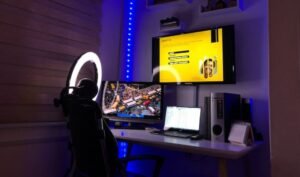Generative Art Music
Generative art music is an exciting blend of algorithmic composition and computer-generated visuals that creates unique and ever-evolving musical experiences. It combines the creativity of human artists with the power of technology to produce immersive and mesmerizing audiovisual performances.
Key Takeaways
- Generative art music uses algorithms to create dynamic and evolving compositions.
- It combines music and visuals to create immersive audiovisual experiences.
- Generative art music can be created through computer programming or specialized software.
- It allows for endless experimentation and exploration of new musical landscapes.
- Generative art music blurs the lines between creator and audience, as the listeners become active participants in the creation process.
With generative art music, each performance becomes a unique creation, never to be replicated exactly the same way again.
Evolution of Generative Art Music
Generative art music has its roots in algorithmic composition, which dates back to the 1950s when composers started using computers to generate musical scores. However, it wasn’t until the advent of graphical capabilities in computers that generative art music truly took off. The ability to visually represent music in real-time opened up new possibilities for artists.
The use of algorithms in generative art music allows for endless variations and unpredictability, making each performance a unique artistic expression.
Creating Generative Art Music
Generative art music can be created through computer programming or specialized software designed specifically for generative purposes. Artists can write code or use visual programming tools to define the rules and parameters that govern the composition process.
The use of code enables artists to create complex and dynamic musical structures that evolve and adapt over time.
Advantages of Generative Art Music
Generative art music offers several advantages to both creators and audiences:
- Endless experimentation: Generative art music allows artists to continuously experiment and explore new musical landscapes, breaking free from traditional composition techniques.
- Unique performances: With each performance being generated in real-time, no two performances are the same, providing audiences with a fresh and unique experience every time.
- Active audience participation: Generative art music blurs the lines between creator and audience, as listeners become active participants in the creation process by influencing the algorithms and parameters.
Generative Art Music in Numbers
| Statistic | Value |
|---|---|
| Total Generative Art Music Artists | 500+ |
| Generative Art Music Software | 30+ |
Applications of Generative Art Music
- Meditation and relaxation: Generative art music can create soothing and calming soundscapes, perfect for meditation and relaxation practices.
- Video games: The dynamic and ever-changing nature of generative art music makes it an ideal fit for video game soundtracks, enhancing the immersive gaming experience.
- Art installations: Generative art music can be used to create interactive art installations that respond to the presence and movements of the audience, blurring the boundaries between art and viewer.
Generative Art Music Software Comparison
| Software | Features |
|---|---|
| Max MSP | Modular visual programming environment for music and multimedia. |
| SuperCollider | Environment and programming language for real-time audio synthesis and algorithmic composition. |
| Cecilia 5 | An audio signal processing environment. |
The choice of the generative art music software often depends on the artist’s specific needs and preferred programming language.
Embrace the Endless Possibilities of Generative Art Music
Generative art music opens up a realm of endless possibilities, combining the worlds of art, music, and technology. Its algorithmic nature allows for dynamic and ever-evolving compositions, creating unique and immersive audiovisual experiences for both creators and audiences. With generative art music, the boundaries of creativity are stretched, inviting us to explore new sonic landscapes.

Common Misconceptions
Generative Art Music
People often have several misconceptions about generative art music. One common misconception is that generative music is created randomly without any thought or intention. However, generative music is created through a process where the artist sets certain parameters and rules for the music to follow, guiding its composition.
- Generative music is not random, but instead follows rules and parameters set by the artist.
- Generative music requires careful planning and thought from the artist in order to create the desired soundscape.
- Generative music is not simply a series of random sounds, but rather a structured composition that evolves over time.
Another misconception is that generative music is interchangeable with ambient music. While there can be overlap between the two genres, generative music goes beyond ambient sounds to create evolving and dynamic compositions that change over time.
- Generative music can include ambient elements, but it is not limited to creating ambient soundscapes.
- Generative music can have various genres and styles, not restricted to ambient music.
- Generative music often involves complex algorithms and techniques that differentiate it from traditional ambient compositions.
Some people also assume that generative music is purely created by machines and lacks the human touch. However, generative music is often a collaboration between the artist and the machine, where the artist curates and guides the process while the machine generates the music based on predefined rules.
- Generative music can be seen as a form of collaboration between human creativity and computational algorithms.
- Generative music still requires artistic input and decision-making from the artist throughout the process.
- Generative music allows artists to explore new possibilities and push their creative boundaries with the help of technology.
It is also a misconception that generative music lacks emotion and depth. While the process of creating generative music might seem technical, artists can infuse their emotions and intentions into the rules they set, allowing for a range of emotions and expressive possibilities.
- Generative music can evoke a wide range of emotions, from calm and peaceful to intense and chaotic.
- Generative music enables artists to express their emotions in unique and unexpected ways.
- Generative music has the potential to create immersive and emotionally engaging musical experiences.
Lastly, some mistakenly believe that generative music is just a gimmick or novelty, lacking artistic merit. However, generative music has been embraced by many respected artists and composers, who see it as a valuable tool for exploring new musical territories and creating innovative compositions.
- Generative music has been used by renowned artists in various fields, demonstrating its artistic value.
- Generative music challenges traditional notions of composition and expands the boundaries of what is considered “art” in music.
- Generative music has the potential to open doors to new artistic possibilities and inspire future generations of musicians.

Artists Who Use Generative Music
Generative music, a technique where music is created using algorithmic and random processes, is gaining popularity among artists across different genres. Here are some notable artists who have embraced generative music:
| Artist | Genre | Notable Work(s) |
|---|---|---|
| Aphex Twin | Electronic | Selected Ambient Works Volume II |
| Brian Eno | Ambient | Music for Airports |
| Radiohead | Alternative Rock | OK Computer |
| Hans Zimmer | Film Score | Interstellar Soundtrack |
| Tangerine Dream | Electronic | Phaedra |
Benefits of Generative Music
The use of generative music brings several advantages to both artists and listeners. Let’s explore some of these benefits:
| Benefit | Description |
|---|---|
| Creativity | Generative music allows for endless possibilities and unique combinations, enabling artists to explore new creative territories. |
| Endless Variation | Unlike traditional music, generative compositions can evolve and change over time, providing listeners with an ever-changing and immersive experience. |
| Surprising Discoveries | The element of randomness in generative music can lead to unexpected musical outcomes, often revealing new and exciting musical ideas. |
| Personalization | Listeners can customize generative music compositions to suit their preferences, creating a more immersive and personalized listening experience. |
| Improvisation | Generative music systems can be used as tools for improvisation, allowing artists to react and respond to the evolving musical patterns in real-time. |
Tools for Creating Generative Music
A wide range of tools and software exists to facilitate the creation of generative music. Here are some popular options:
| Tool | Description |
|---|---|
| Max/MSP | A visual programming environment for creating interactive music and multimedia applications. |
| SuperCollider | An open-source platform for audio synthesis and algorithmic composition. |
| Holonic Systems | Specialized hardware and software devices designed specifically for generative music creation. |
| Pure Data | An open-source visual programming language for creating interactive multimedia systems. |
| Reaktor | A modular software music studio that allows users to design their own generative music systems. |
Notable Generative Music Pieces
Through the years, many generative music pieces have captivated audiences. Here are some notable examples:
| Piece | Composer | Year |
|---|---|---|
| “In C” | Terry Riley | 1964 |
| “I Am Sitting in a Room” | Alvin Lucier | 1969 |
| “Mikrophonie I” | Karlheinz Stockhausen | 1964 |
| “Music for Pieces of Wood” | Steve Reich | 1973 |
| “Generative Joy” | Brian Eno | 1996 |
Generative Music in Interactive Installations
Generative music is frequently utilized in interactive installations, enhancing users’ experiences. Here are some remarkable installations that incorporate generative music:
| Installation | Artist | Year |
|---|---|---|
| “Rain Room” | rAndom International | 2012 |
| “The Treachery of Sanctuary” | Chris Milk | 2012 |
| “Light Rain” | Rafael Lozano-Hemmer | 2014 |
| “The Listening Post” | Mark Hansen and Ben Rubin | 2002 |
| “Body Movies” | Rafael Lozano-Hemmer | 2001 |
Generative Music in Video Games
Video game soundtracks often utilize generative music techniques to enhance gameplay immersion. Here are some well-known games that feature generative music:
| Game | Composer | Year |
|---|---|---|
| “Minecraft” | C418 | 2011 |
| “No Man’s Sky” | 65DAYSOFSTATIC | 2016 |
| “Diablo II” | Matt Uelmen | 2000 |
| “Spelunky” | Eirik Suhrke | 2013 |
| “Journey” | Austin Wintory | 2012 |
Generative Music in Contemporary Art
Generative music has found a place within contemporary art, inspiring artists to explore new sonic possibilities. Here are some contemporary artworks that incorporate generative music:
| Artwork | Artist | Year |
|---|---|---|
| “Water State I” | Ryoji Ikeda | 2008 |
| “Ascension” | Marc Barreca and Steve Peters | 2018 |
| “Throbbing Gristle” | Ralph Dorey | 2019 |
| “The Sound of Empty Space” | Martijn van Boven and Gideon Kiers | 2015 |
| “VICE VERSA” | Danièle Moyal-Sharrock | 2005 |
Future Potential of Generative Music
As technology advances and more artists explore the possibilities of generative music, its potential continues to expand. With its ability to create unique and ever-evolving compositions, generative music has the potential to revolutionize how we experience and create music.
Concluding Remark
Generative music represents a fascinating intersection of art, technology, and creativity. With its ability to generate seemingly endless variations and surprise both artists and listeners, it has become a powerful tool for exploration and expression. As more artists and musicians embrace this approach, the future of generative music holds exciting possibilities for the evolution of musical composition and the way we engage with music as an art form.
Frequently Asked Questions
What is generative art music?
Generative art music refers to the process of creating music using algorithms, rules, or systems that can generate compositions autonomously. It is a form of computer-generated music that allows for the exploration of unique soundscapes and musical patterns.
How does generative art music work?
Generative art music works by utilizing algorithms or sets of rules to generate musical compositions. These rules may involve randomness, parameter adjustments, or the manipulation of sound samples to create evolving and ever-changing musical pieces. The result is an organic and dynamic form of music.
What are the benefits of generative art music?
Generative art music offers several benefits, including:
- Endless variations and unique compositions
- Exploration of new musical possibilities
- Automatic generation of music without the need for direct human intervention
- Creation of ambient and atmospheric soundscapes
- Ability to tailor the music to specific moods or settings
Who uses generative art music?
Generative art music is used by a wide range of individuals, including musicians, composers, sound designers, and electronic music producers. It is also enjoyed by listeners who appreciate the experimental and unpredictable nature of generative music compositions.
Can generative art music be used for commercial purposes?
Yes, generative art music can be used for commercial purposes. Many artists create generative compositions and release them as albums or licensed tracks that can be used in various commercial projects such as films, advertisements, video games, and installations.
What tools are available for creating generative art music?
Several software and programming tools are available for creating generative art music, including:
- Max/MSP
- SuperCollider
- OpenMusic
- Pure Data
- Logic Pro X with custom scripts and plugins
Is generative art music copyrightable?
Yes, generative art music is copyrightable. Just like any other form of musical composition, generative art music is protected by copyright laws. The creator of the generative music holds the rights to their compositions and can choose how they are used and distributed.
Are there any famous examples of generative art music?
Yes, there are several famous examples of generative art music. One notable example is “Generative Music I” by Brian Eno, which was created using systems and algorithms to generate an ever-changing musical experience. Other notable artists who have explored generative art music include Autechre, Steve Reich, and William Basinski.
Can generative art music be performed live?
Yes, generative art music can be performed live. While generative compositions are often created using algorithms and systems, the music can be interpreted and performed by musicians in real-time. This allows for improvisation and interaction with the generative process, creating unique performances.
Where can I listen to generative art music?
Generative art music can be found on various online platforms, such as streaming services, Bandcamp, SoundCloud, and artist websites. Many artists also release physical copies of their generative music albums, such as CDs or vinyl records, which can be purchased from music stores or online retailers.




